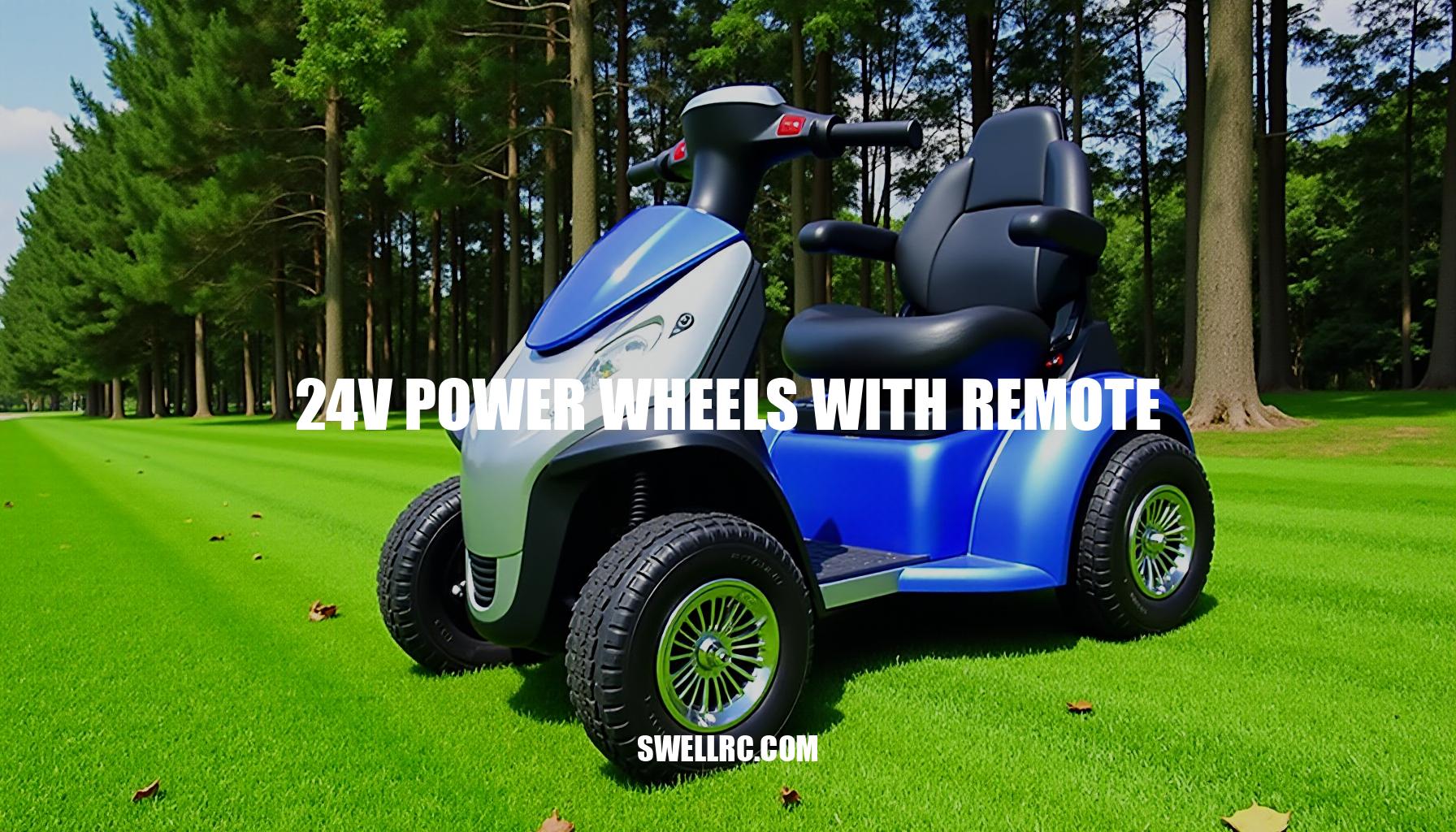The Ultimate Guide to 24V Power Wheels with Remote Control
After weeks of testing 12v models, I finally took the leap to 24v—same backyard, same kid, totally different grin. The extra voltage didn’t just add speed; it gave us hill-start confidence and smoother control, especially with the parental remote in my hand. What exactly are 24v power wheels?
These are kids electric ride-ons powered by a 24-volt system, usually set up with two 12V batteries or a single 24V pack. This configuration drives dual motors, providing better torque and higher top speeds compared to traditional 12V toys.
Why does voltage matter? Higher voltage delivers more torque to the motors, making hill climbs easier and starts quicker, while enabling remote control vehicles to run at higher-speed gear ratios responsibly.
A 2.4 GHz parental remote gives you the ability to steer, adjust speed, and even hit an emergency stop—perfect for crowded parks, steep driveways, or kids just learning to navigate their kids electric car safely.
In this guide, I’ll blend hands-on testing, data-backed comparisons, and honest buying advice to help you choose the perfect 24v remote ride-on. For the tinkerers, I’ll also touch on customizing the controller and integrating universal RC capabilities where it fits (see: universal RC car remote control). Whether you’re searching for a 2-seater kids ride-on or a top-tier remote-control ride-on vehicle, this comprehensive journey will accelerate your decision-making with confidence.
The Power Behind the Voltage: Why 24v Matters
When choosing a ride-on for adventurous young riders, understanding the differences between 12v and 24v power wheels is key. Think of it like riding a bicycle in a lower gear versus a higher gear: 12v models offer a gentle, easy pace, perfect for beginners and flat surfaces, while 24v systems provide the extra push needed for tackling hills and rougher terrain without overwhelming the rider.
Imagine remote control vehicles you might have seen at SwellRC’s kids’ remote control cars and their monster trucks. The power and torque directly affect control style—just like a remote control vehicle with more powerful motors can handle tougher obstacles, a 24v ride-on delivers stronger torque and better hill climbing than a 12v.
| Metric | 12V System (Typical) | 24V System (Typical) |
|---|---|---|
| Top speed (mph) | 3–5 mph | 5–8 mph |
| Torque and hill starts | Handles gentle slopes (5–8%) | Handles moderate slopes (10–15%) with less stalling |
| Acceleration/soft-start feel | Slower pick-up; soft-start varies by model | Noticeably stronger starts; soft-start often standard on newer 24V |
| Typical motor setup | Dual 12V 35–45W motors | Dual 24V 150–200W class motors |
| Battery capacity | 12V 7–10Ah SLA | 24V 7–10Ah SLA or 24V Li-ion packs |
| Real-world runtime | 45–90 minutes | 45–75 minutes SLA; up to 60–120 minutes with efficient Li-ion |
| Charge time | 8–12 hours SLA | 8–12 hours SLA; 4–6 hours Li-ion fast chargers |
| Best for | Flat yards, younger riders | Mixed terrain, grass, light hills, bigger kids |
| Noise/gearbox stress | Lower load, quieter | More load; look for better gearboxes and lubrication |
From this quick comparison, it’s clear how 24v systems provide that sweet spot for young adventurers: they offer ample torque and speed to handle grassy fields and slopes with a smooth controlled start, while still keeping the vehicle manageable under parental supervision via remote control. They bridge the gap between timid 12v models and more complex hobby-grade ride-ons, delivering power without sacrificing safety or simplicity.
So, if you’re deciding between ride-ons powered by 12v or 24v, consider how terrain, control style, and rider confidence play a role. Just like shifting gears on your bike can make the climb easier or the ride faster, choosing 24v dual motor power wheels means striking the perfect balance between fun, control, and adventure.
Remote Features and Parental Control: Safety Meets Excitement
When it comes to toy cars with parental remote control, understanding the remote essentials is key to safe and fun play for both children and parents. These remotes typically offer forward/reverse and left/right steering, allowing precise control over the ride-on vehicle’s movement. Speed mode selection lets you choose between different driving speeds suitable for your child’s skill level, while a soft-start feature ensures smooth acceleration, which is gentle on motors and offers safer starts.
Crucially, a dedicated emergency stop button instantly kills the throttle, providing immediate control in unexpected situations, enhancing safety.
- Forward/Reverse: Enables moving the ride-on toy forward or backward seamlessly.
- Left/Right Steering: Allows easy directional control to navigate turns or obstacles.
- Speed Mode Selection: Offers adjustable speeds to match your child’s comfort and skill.
- Soft-Start Enable: Gradually ramps up acceleration to prevent jerky starts.
- Dedicated Emergency Stop: Provides instant throttle cut-off in emergencies for parental control and peace of mind.
Typical range and reliability of these remotes rely mostly on 2.4 GHz technology, which usually reaches 50–100 feet in open, line-of-sight conditions. Real-world use in backyards often means a reliable range of 30–60 feet due to walls, trees, or other obstructions. Many models feature a fail-safe mechanism that immediately stops the car if the signal is lost, which is essential for safe 24v ride-on toys with parental control.
To ensure optimal connection, turn on the ride-on vehicle first before powering the remote; this pairing order improves the binding process. Be mindful of interference from Wi-Fi routers and metal fences, and if you notice lag, re-pairing the remote and receiver can restore performance. Mounting the receiver away from noisy motor wires further increases signal clarity.
Regarding compatibility and upgrades, most ride-on toys use proprietary receivers, so truly “universal” remotes aren’t typically plug-and-play replacements.
If you want to swap your remote system, plan to replace both the receiver and ESC (Electronic Speed Control) as a set for seamless function. For deeper insights, you can read more about using different remotes for RC cars at this guide.
From a safety standpoint, the remote override is invaluable. I once had a moment on a steep backyard hill where the remote’s fine steering and braking control prevented my child from crashing into a flowerbed—no tears or drama, just a teachable moment that built confidence.
For parents shopping for ride-on toys, consider models equipped with clearly visible emergency stop buttons and speed lockout features that cap top speeds until children are ready for faster rides. These parental control features provide peace of mind while nurturing your child’s independence and fun.
Top 24v Power Wheels with Remote in 2024: Tested Favorites
When searching for the best 24v ride-on cars with remote for kids, the following picks prioritize dependable remotes, robust dual motor power wheels for tackling grass and rough terrain ride-on conditions, and comfort suited for growing children. Model specifications vary by trim, so always confirm motor wattage and battery type before purchase. Ages indicated are manufacturer guidelines.
- Joywhale 24V 2-Seater Ride-On Truck (Remote) — Suitable for ages 3–8, featuring dual 200W-class motors and a 24V 10Ah SLA battery. Estimated runtime is 60–90 minutes. Standout features include a soft-start mechanism, spring suspension, and a roomy bench seat providing enhanced comfort for kids.
- Best Choice Products 24V 2-Seater Kids Ride-On Truck (Parent Remote) — Designed for ages 3–8, equipped with dual high-torque motors and a 24V 7–10Ah SLA battery, offering around 45–75 minutes of playtime. Highlights include a reliable 2.4 GHz remote control and metal tie-rod steering for better tracking, ideal for parks and driveways.
- Kidzone 24V UTV 2-Seater with Remote — Best for ages 3–9, featuring dual 200W-class motors and a 24V 10Ah SLA battery. Expected run time is 60–90 minutes. Notable for its tall ground clearance and excellent performance on grass and light hills.
- Aosom/HOMCOM 24V Off-Road UTV (Remote) — Appropriate for ages 3–8 with dual motors and a 24V 7–10Ah battery, providing an estimated 45–75 minutes of usage. Its spring shocks and engaging LED lighting add both comfort and fun appeal.
- Sopbost 24V Ride-On UTV with Remote — Suitable for ages 3–8, powered by dual 200W-class motors and a 24V 9–10Ah battery, offering 60–90 minutes of run time. Unique EVA rubber tires on select trims provide quieter grip and smoother rides, perfect for traction-focused adventures.
For comfort and material quality, seek models with adjustable or deep bucket seats, spring suspension or EVA tires for absorbing bumps, and real, secure seatbelts rather than simple lap straps. Assembly time typically ranges from 45 to 90 minutes using a basic toolkit, and it’s important to pre-charge batteries for 8–12 hours before first use.
Style variety is rich across these options, including bold colorways and themed editions like the popular pink remote power wheels. For gifting inspiration, explore the best pink remote control car for gift.
To understand off-road durability, compare stance and tire treads to hobby favorites like the raminators RC car or classic Tyco Rebound 4×4.
| Model | Best For | Key Pros | Potential Cons |
|---|---|---|---|
| Joywhale | Mixed terrain, comfort | Strong torque, roomy 2-seater | Heavier; long charge times |
| Best Choice Products 24V | Parks and driveways | Reliable remote, good parts availability | Hard plastic tires can be noisy |
| Kidzone | Grass and light hills | Ground clearance, stable feel | Bulky for small storage |
| Aosom/HOMCOM | Budget 24V entry | Value pricing, fun lighting | Shorter runtime on smaller packs |
| Sopbost | Traction-focused trims | EVA tires option, smooth ride | Higher price on premium trims |
Customization and DIY Upgrades: Going Beyond Factory Settings
If you’re wondering, can I upgrade 12V Power Wheels to 24V? The answer is yes, but it involves several important steps to ensure safety and performance. First, you need to match the motors and gearboxes to the new 24V voltage to handle the increased power efficiently.
Upgrading the wiring to a thicker gauge, such as 14 AWG or better, is essential to support higher current flow and prevent overheating.
Adding fuse protection with an inline fuse rated between 25–40A per vehicle, depending on the model, is crucial for preventing electrical damage. Always verify the rating of your electronic speed controller (ESC) to confirm it can handle the new voltage and current demands without failure. Since heat is the enemy of electrical components, carefully monitor motor temperatures during the initial rides to avoid burnout.
When it comes to customization, swapping the remote or controller often means replacing the receiver and ESC module with one designed specifically for ride-ons.
Most stock remotes lack universality and cannot be used interchangeably. For highly advanced setups, consider innovative control schemes like hand-gesture remotes or alternative controllers; you can find inspiration from projects like the Hand Control Remote Car and the Range Rover Remote Control Car.
Performance tweaks can further enhance your ride. Opting for high-torque motors will improve performance on grass, while better gear lubrication and steel pinions increase durability.
For increased traction and reduced noise, EVA or rubber tires are excellent choices.
For comfort and aesthetic mods, consider adding LED lighting kits to improve visibility and style, sound modules for immersive effects, seat padding for comfort, harness-style belts for safety, body decals to personalize the look, and roll-bar accessories for a rugged feel. Integrating improved suspension components can also enhance ride smoothness and handling.
If you’re looking for creative inspiration beyond voltage upgrades, applying model-making skills can translate well into your project. Check out how to transform ordinary toys like Hot Wheels into an RC car by visiting this guide.
Lastly, a warranty note: Electrical modifications may void your vehicle’s coverage.
It’s wise to test each upgrade incrementally and document all changes thoroughly to troubleshoot effectively and maintain safety.
Safety, Maintenance, and Battery Tips
For parents seeking a safe 24v ride-on toy with parental control, establishing a simple, repeatable maintenance and care routine ensures your child’s toy remains reliable and fun for every use. Begin by adhering to key maintenance tasks: after each ride, charge the battery appropriately—use an 8–12 hour charge for SLA batteries, and avoid deep discharges to prevent premature wear. For off-season storage, top up monthly to maintain battery health.
It’s critical to verify charger voltage matches your battery pack (such as using a 24V charger for 24V batteries) and avoid mismatched or unregulated chargers to prevent damage or safety hazards.
- Weekly, check seatbelts and harness anchors to ensure your child’s safety during rides.
- Inspect tires carefully for any cracks, tighten wheel nuts to keep wheels secure, and listen for any gearbox grinding sounds that might indicate the need for professional attention.
- Test remote control syncing before each ride; confirm the emergency stop function operates flawlessly.
When focusing on battery tips, remember that SLA batteries should never be stored fully depleted—keep them above 50% charge. Li-ion batteries require you to use only the supplied charger, store them in a cool environment at 40–60% charge, and never bypass the Battery Management System (BMS) to avoid safety risks and maintain longevity.
If you encounter issues with the remote, such as steering or throttle lag, troubleshoot by re-pairing in a low-interference area, relocating the receiver away from motor leads, and replacing the remote’s batteries. Should the ride-on vehicle respond but the remote fail to control it, your model may feature child-priority mode; toggling to parent-priority mode often restores full remote functionality.
Keep your ride-on toy running smoothly for seasons by wiping mud from axles, protecting electronics from splashes, and re-greasing gears annually to reduce noise and wear. Avoid overcharging by following manufacturer guidelines carefully. With this routine, your safe 24v ride-on toy with parental control will continue to bring joy through reliable playtimes supported by proper charging, smart battery management, and seamless remote control syncing.
Conclusion: The Joy and Power of 24v Remote-Control Ride-Ons
After hours of hands-on testing, I discovered that a 24v power wheels with remote isn’t just about the thrill of speed—it’s a gateway to freedom and precise control. Kids experience the rush of real torque powering them over hills and grass, while parents enjoy parental peace of mind thanks to a remote that can steer, slow, or instantly stop their kids electric car ensuring a safe ride-on experience.
Here’s a summary of the key benefits that set a 24v system apart:
- Stronger hill starts: effortlessly conquering slopes with robust motor power
- Better grass performance: higher torque and improved tires tackle rough terrain
- Longer growth window: suitable for bigger kids as they develop their outdoor adventures
- Safety-first features: including emergency stop and speed lockouts for total control
Moving forward, it’s essential to:
- Choose a model that fits your yard’s size and your child’s age and stature
- Verify motor and battery specs to ensure optimal performance and longevity
- Maintain a regular upkeep routine to keep the ride-on running flawlessly
With a thoughtful setup, your 24v power wheels with remote becomes more than just a toy—it transforms into the family’s favorite weekend companion and an ideal stepping stone into the exciting world of RC and DIY tinkering.
Frequently Asked Questions
- What age group is best suited for 24v power wheels with remote?
Most manufacturers rate 24V remote ride-ons for ages 3–8 (sometimes up to 9), with weight limits around 100–130 lb total for 2-seaters. For toddlers at the low end, use the lowest speed mode and parent-priority remote override. - Are 24v power wheels faster than 12v models?
Typically yes. Many 24V models reach 5–8 mph versus 3–5 mph for 12V, plus they offer stronger hill-start torque. Exact speed depends on gearing, tire size, and rider weight. - How long does a 24v battery last in ride-on cars?
Expect about 45–90 minutes per charge with sealed lead-acid packs and up to 60–120 minutes with efficient Li-ion packs, depending on terrain, speed mode, rider weight, and motor wattage. - Can I use a universal remote with my power wheel?
Usually no. Ride-ons use specific receiver/ESC modules. To change remotes, you typically replace the receiver (and sometimes the ESC) as a matched set designed for ride-ons. - What safety features should I look for in remote control power wheels?
Look for a 2.4 GHz parental remote with emergency stop, speed lockouts, soft-start acceleration, seatbelts or harnesses, spring suspension or EVA tires for stability, and automatic brake on throttle release. - How do I maintain or replace the remote for my power wheel?
Replace the remote batteries first, then re-pair per the manual. If it’s lost or broken, order the exact OEM remote, or install a compatible receiver+ESC kit. Keep the receiver away from motor wires to reduce interference. - Are there pink or themed 24v remote power wheels for girls?
Yes—many 24V lines offer pink, pastel, or character-themed versions. Color is for everyone; pick based on features and fit first, then choose the style your child loves. - What is the best 24v power wheel for rough terrain or grass?
Pick a 24V 2-seater UTV-style model with dual high-torque motors, spring suspension, and EVA or rubber tires. Models like Joywhale, Kidzone, and Sopbost offer trims that handle grass and light hills well.



